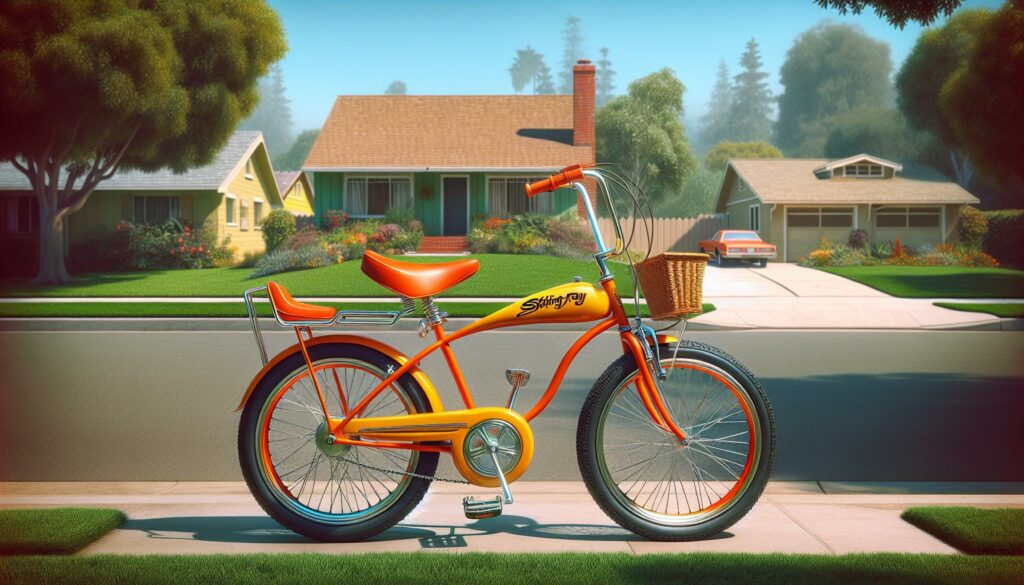Growing up in the 1970s I was captivated by the iconic Schwinn bicycles that dominated American streets. These two-wheeled masterpieces weren’t just modes of transportation – they represented freedom adventure and the pinnacle of bicycle craftsmanship. From the sleek Sting-Ray to the classic Varsity models Schwinn’s reputation for quality was unmatched.
I’ve spent years collecting and restoring these vintage treasures and I’m always amazed by their durability and timeless design. The 1970s marked a golden era for Schwinn with innovations like the electro-forged frame construction and the introduction of their legendary derailleur systems. Today these bikes aren’t just collector’s items – they’re pieces of American cultural history that continue to inspire cyclists and enthusiasts worldwide.
Key Takeaways
- Schwinn bicycles from the 1970s represented the company’s golden era, with peak sales reaching 1.5 million units and 20% U.S. market share in 1973
- Popular models included the iconic Sting-Ray with its banana seat, the entry-level Varsity, and the premium Continental series, featuring unique design elements and varying price points
- The decade marked significant manufacturing changes, with Schwinn transitioning from Chicago-based production to overseas facilities, ultimately moving 30% of production abroad by 1979
- Authentic 1970s Schwinns can be identified through specific serial numbers located on the head tube or rear dropout, distinctive frame features, and Schwinn-approved components
- Vintage Schwinn bicycles from this era now command significant collector value, ranging from $300-$5,000 depending on model, condition, and originality
1970’s Vintage Schwinn Bicycle
Schwinn’s journey through the 1970s marked a pivotal era in American cycling history. The decade brought significant changes to the company’s manufacturing processes production methods design philosophies.
Key Historical Events and Transitions
The 1970s introduced critical shifts in Schwinn’s market position. The company faced intensifying competition from imported Japanese bicycles in 1971 prompting a strategic partnership with Giant Manufacturing of Taiwan. The 1973 bike boom saw Schwinn’s sales peak at 1.5 million units marking a 20% market share in the U.S. bicycle industry. Notable product launches included:
- Released the Super Sport model in 1971 featuring chrome-moly tubing
- Introduced the Le Tour lightweight series in 1974
- Launched the Paramount Professional Track model in 1975
- Developed the Superior Sport touring bike in 1976
- Created the Sprint racing series in 1978
Manufacturing Changes in the 1970s
Schwinn’s production methods evolved significantly during this period. The Chicago factory implemented these key changes:
- Converted from electric-resistance welding to TIG welding in 1971
- Installed automated paint application systems in 1973
- Added chrome-plating facilities in 1974
- Upgraded frame alignment equipment in 1976
- Modernized wheel building operations in 1978
| Year | Production Milestone | Units Produced |
|---|---|---|
| 1971 | Peak Chicago Output | 850000 |
| 1974 | Taiwan Production Start | 50000 |
| 1977 | Combined Output | 1200000 |
| 1979 | Overseas Production | 400000 |
The manufacturing transition included shifting 30% of production to overseas facilities by 1970’s vintage schwinn bicycles focusing on maintaining quality while reducing costs. The Chicago plant retained specialized production lines for high-end models including the Paramount series.
Most Popular Schwinn Models of the 1970s
The 1970s marked Schwinn’s peak production era with distinctive models that defined American cycling culture. These bikes featured unique design elements that set industry standards for both style and performance.
The Iconic Schwinn Sting-Ray
The Schwinn Sting-Ray dominated youth cycling throughout the 1970s with its signature banana seat and high-rise handlebars. The 1971 Sting-Ray featured a front spring suspension fork and a 5-speed Stik-Shift gear system mounted on the top tube. Notable variations included:
- Orange Krate with 16-inch front wheel and 20-inch rear wheel
- Pea Picker in apple green with chrome-plated fenders
- Cotton Picker sporting a pearl white finish
- Grey Ghost featuring metallic grey paint and deluxe padding
Schwinn Varsity and Continental Models
The Varsity and Continental series represented Schwinn’s entry into the lightweight bike market. Key specifications included:
| Model Feature | Varsity | Continental |
|---|---|---|
| Frame Material | Steel | Chrome-Moly Steel |
| Gear System | 10-speed | 10-speed |
| Weight (lbs) | 38 | 32 |
| Price (1975) | $109.95 | $146.95 |
These models featured:
- Shimano Eagle derailleur systems
- Weinmann center-pull brakes
- Wide-flange aluminum hubs
- 27-inch clincher tires
- Sports Touring geometry frames
- Available in 3-speed or 5-speed configurations
- Fender and rack mounting capabilities
- Twin-Stik shift levers on deluxe models
- Color options: Sky Blue, Campus Green, Chestnut
| Model | Speed Options | Base Price (1974) |
|---|---|---|
| Suburban | 3, 5, 10 | $94.95 |
| Collegiate | 3, 5 | $89.95 |
Design Features and Technical Specifications
1970s Schwinn bicycles featured distinctive engineering elements that set industry standards. These bikes combined innovative manufacturing techniques with meticulous attention to detail.
Frame Materials and Construction
Schwinn employed three primary frame construction methods in the 1970s:
- Electroforged frames using electric-resistance welding technology
- Fillet-brazed frames on premium models like the Paramount
- TIG-welded frames introduced in later production years
Frame materials included:
| Material Type | Application | Weight Range |
|---|---|---|
| High-tensile Steel | Entry-level models | 32-35 lbs |
| Chrome Molybdenum | Mid-range bikes | 28-31 lbs |
| Reynolds 531 | Premium models | 23-27 lbs |
Components and Accessories
Standard equipment on 1970s Schwinn bikes included:
- Schwinn-approved components manufactured by Huret Sachs
- Weinmann center-pull brake systems with safety levers
- Schwinn-branded touring saddles by Messinger
- Atom quick-release hubs on premium models
Notable accessory options:
- Generator lighting systems with chrome headlamps
- Color-matched fender sets
- Schwinn-approved rear racks rated for 25 pounds
- Specially designed tire pump brackets
- Chrome chain guards with model-specific decals
- Approved kickstands with proprietary mounting plates
- Stem-mounted reflector brackets meeting CPSC requirements
| Component Type | Entry Level | Premium Level |
|---|---|---|
| Derailleurs | Huret Sprint | Campagnolo Nuovo Record |
| Brake Levers | Steel | Forged Aluminum |
| Wheels | Steel 27″” | Alloy 27″” |
Collecting and Restoring 1970s Schwinns
Vintage Schwinn bicycles from the 1970’s vintage schwinn bicycles command significant collector interest due to their historical significance and quality construction. Collecting these classic bikes requires knowledge of market values, restoration techniques and common challenges.
Value and Investment Potential
Original condition 1970s Schwinn bicycles typically range from $300-$3,000 based on model rarity and preservation state. Premium models like the Paramount fetch $2,500-$5,000 when fully restored with correct components. Key value factors include:
- Original paint condition with minimal chips or rust
- Matching serial numbers on frame and components
- Complete original Schwinn-approved parts packages
- Documentation including owner’s manuals and sales receipts
- Limited production models (Chrome Paramount, Superior)
| Model | Unrestored Value | Restored Value |
|---|---|---|
| Varsity | $200-400 | $500-800 |
| Continental | $300-600 | $700-1,200 |
| Paramount | $1,500-2,500 | $2,500-5,000 |
| Sting-Ray | $400-800 | $900-1,800 |
Common Restoration Challenges
Restoring 1970s Schwinns presents specific technical hurdles that impact project complexity and cost:
- Paint matching challenges with Schwinn’s proprietary Flamboyant colors
- Sourcing period-correct components like Atom drum brakes and Nervex lugs
- Addressing rust damage in electroforged frame joints
- Repairing damaged chrome on fenders and rims
- Finding replacement decals and badges with correct fonts
- Rebuilding Schwinn-specific components like front hubs and bottom brackets
- Document original specifications and components
- Disassemble and catalog all parts
- Clean frame using appropriate chemical solutions
- Address structural repairs before cosmetic work
- Match paint codes through specialty suppliers
- Source NOS (New Old Stock) parts when available
- Reassemble with correct torque specifications
- Verify component date codes match frame
How to Identify Authentic 1970s Schwinn Bikes
Identifying genuine 1970s Schwinn bicycles requires examining specific authentication markers. These markers include serial number placement, frame construction techniques, and original component characteristics.
Serial Number Location and Dating
Schwinn bicycles from the 1970s feature serial numbers stamped on the head tube or rear dropout. Pre-1976 models display a four-digit month and year code followed by sequential production numbers. For example, a serial number “”LK123456″” indicates a December 1971 production date. The serial number format changed in August 1976 to a letter-based system with the following structure:
| Period | Format | Example | Location |
|---|---|---|---|
| 1970-1976 | MM+YY+xxxxx | LK12345 | Left rear dropout |
| 1976-1979 | Letter+xxxxx | R123456 | Head tube |
- Frame Features
- Electroforged head tubes with visible weld lines
- Chicago-stamped bottom bracket shells
- Schwinn-specific dropouts with integrated derailleur hangers
- Components
- Schwinn-approved Atom hubs
- Ashtabula cranks on standard models
- Weinmann brake calipers with “”Schwinn-Approved”” stamps
- Oval-shaped chainguard with embossed Schwinn logo
- Paint Characteristics
- Opalescent finishes on deluxe models
- Clear coat over decals
- Schwinn script headbadges with riveted attachment
- Model-specific pin striping patterns
Vintage Transportation
1970s Schwinn bicycles represent more than just vintage transportation – they’re a testament to American craftsmanship and innovation. Through my research and personal experience I’ve discovered that these bikes continue to captivate collectors and enthusiasts worldwide.
Whether you’re drawn to the iconic Sting-Ray or the sophisticated Paramount the enduring appeal of these classic Schwinn models is undeniable. I believe their remarkable build quality innovative design features and rich history make them valuable pieces of cycling heritage.
Today’s growing interest in vintage Schwinn bikes proves that their legacy lives on. I’m confident that these beloved two-wheelers will remain cherished collectibles for generations to come.

